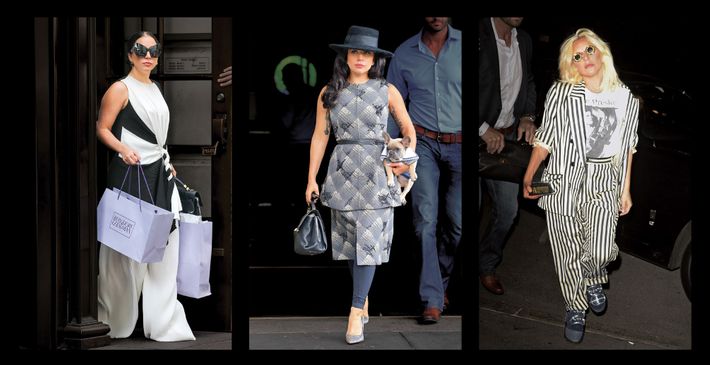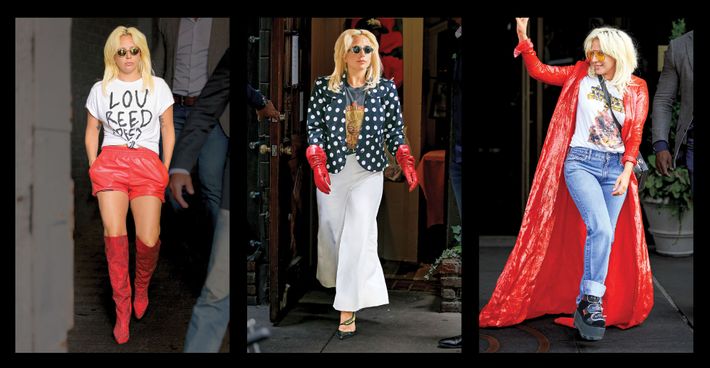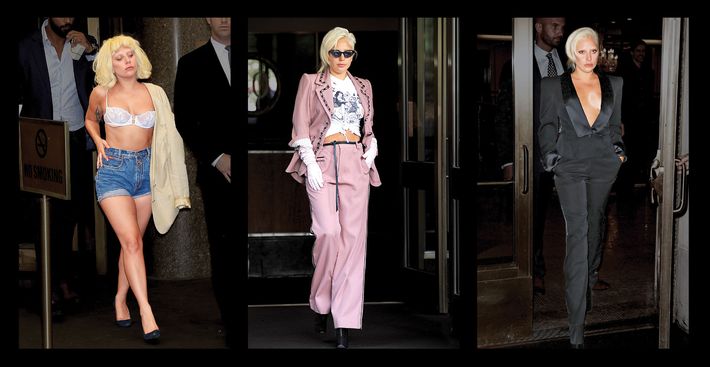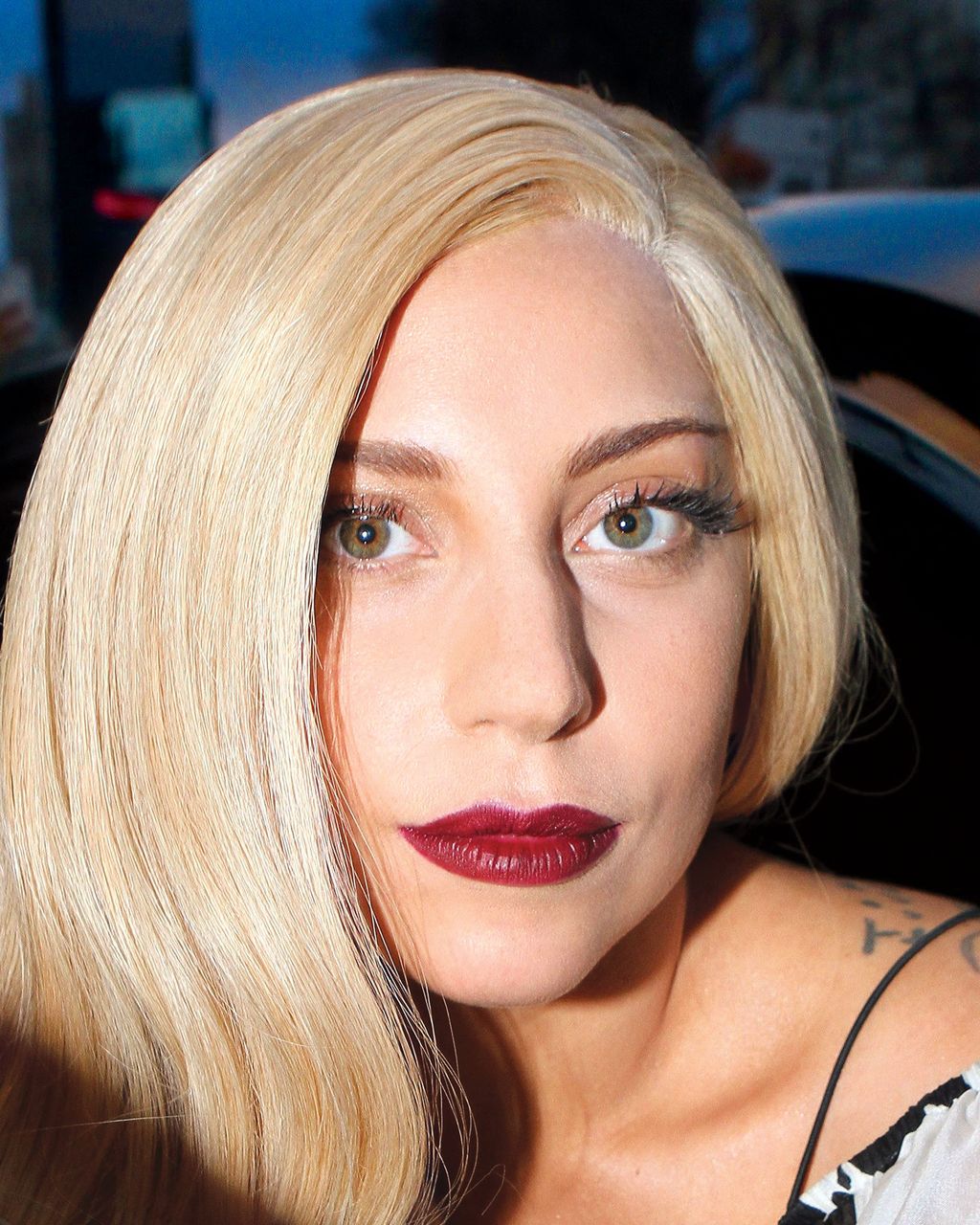This piece originally ran in July. We are republishing it in advance of the American Horror Story: Hotel premiere tonight.
It’s late June at Radio City Music Hall, and Lady Gaga is playing a joke on Tony Bennett, or maybe — it’s always a little hard to tell with her — Lady Gaga is playing a joke on us. This is the third of four nights that the unlikely-yet-somehow-inevitable May-December pair have sold out and the latest stop on their “Cheek to Cheek” tour, which runs into early August and follows their chart-topping 2014 album of jazz standards. Gaga has just finished an explosive, gusty, and gloriously butch rendition of the old Cher hit “Bang Bang (My Baby Shot Me Down).” Her look: ruby-red stilettos, punky print T-shirt, well-tailored jacket and pants. It’s her first official showstopper of the night. Showcasing her growly lower register, her version of the song has a feeling of aggression rather than resignation — the way she sings it, you’d swear she was the one holding the gun. The crowd applauds. She leans toward us conspiratorially. “Don’t tell Tony,” she says with that signature New York–theater–kid affect, “but this is his suit.”
This is also, largely, his crowd. The scene in the Hall’s plush lobby is quite different from the one I remember from the last time I saw Gaga live, almost exactly a year prior, when her blaring, vaguely under-the-sea-themed “artRAVE” tour stopped at Madison Square Garden. There, freak flags were flying, but tonight, everything’s much more subdued. Expensively dressed and aggressively hetero men tote around dolled-up dates; grandparents abound; the woman in front of me at the bar asks for ice in her white wine. I spot a few unmistakable Little Monsters, but even they seem to have classed it up for the occasion: A man walks by in a beaded, floor-length evening gown. I try to decide if it’s a mark of her changing cultural significance or my own slow-but-steady maturity that this is the first Lady Gaga concert to which I have not worn a wig.
So, again, not exactly her crowd — which means, of course, that it’s hers to win over.
And she does, with ease. I hear it murmured a row back after “Bang Bang,” and I will hear this particular sentiment at least a dozen times tonight, and I have heard it said incessantly over the past few months: “Wow, I had no idea that Lady Gaga can really sing.”
This phrase seemed to be on everybody’s lips in February when, with 36 million people watching, the artist formerly known as Stefani Germanotta belted out a stunning, triumphant, and technically impressive Academy Award telecast tribute to The Sound of Music. As a beaming Julie Andrews hugged her in appreciation after she’d finished singing, you knew you’d just witnessed one of those universally respected, generation-uniting musical moments that we so rarely get in this era of Twitter-sniping — for one peaceful evening, everybody seemed to be bowing down to Gaga. (“Congratulations to Lady Gaga and Julie Andrews for a most emotional moment on this year’s Oscars,” Steve Martin tweeted. “Oops, forgot to be satirical.”) Since we must now predict the long-term cultural significance of a televised event before we’ve even broken for commercial, pundits had declared the performance an irrefutable turning point in Lady Gaga’s career by the time the Best Picture envelope was ripped open. Quoth BuzzFeed at 11:41 that night: “Her Sound of Music medley at the Oscars showed that she’s left behind her days of perishable dresses and #ArtPop performances once and for all.”
Did it, though? That was the question on my mind at Radio City, and leading up to the tour all signs have pointed to yes — Gaga seems to be running with this “Damn, she really can sing” thing. Her latest video to make the rounds online is not one of, say, a performance artist vomiting on her (March 13, 2014) or a demonstration of “Volantis, the World’s First Flying Dress” (November 11, 2013) but … a clip of her singing “La Vie en Rose” in a pink dress at the Hollywood Bowl. I’m sure plenty are happy to see her so-called gimmicks fall by the wayside, and I have to admit there’s something thrilling about watching one of the biggest pop stars of the past decade make such a sudden artistic pivot. But must she give up those attention-grabbing spectacles once and for all in order for us to take her seriously as a “real” artist? Perhaps a little selfishly, I’m worried about what might happen if Gaga goes fully normal. After all, we’re talking about the woman who, bless her heart, rescued us all from normal in the first place.

Given the staggering progress we’ve made lately with gay rights and the attention paid to transgender issues, it is perhaps inconvenient for us as a culture to remember how many people, less than a decade ago, truly believed that Lady Gaga had a dick.
The rumor began around 2009, when Gaga’s debut album, The Fame, was still riding high on the charts, thanks to the fun-but-faceless sleeper hit “Just Dance” and the undeniable, star-making smash “Poker Face.” Nobody knew quite what to make of her back then, this woman who made conventional-sounding electro-pop but walked, talked, and dressed like an alien visitor from a planet on which everybody is a descendant of Klaus Nomi. When it came to female pop stars, we were still reeling from the Britney-Christina-Jessica era, during which the only acceptable kind of femininity that presented itself was au naturel — eternally sun-kissed and low-cut-jean ready and never having anything too weird or opinionated to say. In this world, Gaga’s take on femininity — all boxy silhouettes, cyborgian dance moves, and grand, Warholian pronouncements — was, to many, utterly illegible. “I’m not going to make a guy drool the way a Britney video does,” she said in an early interview. “[W]hat I do is so extreme. It’s meant to make guys think: I don’t know if this is sexy or just weird.”
Gaga was something different and less explicitly “hot” than the female pop stars who had come before her. So naturally the internet responded by creating an elaborate conspiracy theory about her genitals. A video purporting to show something unidentifiable in her leotard went viral; for the better part of two years, websites like Gawker made a sport of enlarging concert photographs of her crotch. (A sample entry from the site’s extensive “lady gaga penis”–search archive: “Lady Gaga’s Vagina Almost Fooled Us Into Forgetting About Her Penis.”)
In hindsight, this might end up looking like pop culture’s last major moment of gay-and-trans panic. The early and mid-aughts, remember, were a woefully conservative time in pop music when it came to sexual identity and gender presentation. Lance Bass couldn’t come out for fear of alienating his fan base; any speculation that Britney “wasn’t a real woman” would have called her greatest value, her male-gaze-approved hotness, into question. So what was exhilaratingly radical to me about Gaga at the time was that this kind of speculation didn’t ruffle her — she seemed to actively court confusion about her gender, sexuality, and even species, as though any kind of inscrutability only made her more powerful and alluring. (She joked about her “dick” in 2010, in the now-classic “Telephone” video; she wore a strap-on on the cover of Q.) Seeing all this happening during the era of “no homo” felt revolutionary.
Growing up — much like, I am going to estimate, 100 percent of the population — I felt stifled by the stereotypes and expectations of my gender. Even from the privileged position of being a straight, white, cisgender woman, I still walked around in a constant panic that I was doing femininity wrong. (I tripped every time I put on heels. I played sports a little too competitively in gym class. I went through a very unfortunate brown-lipstick phase.) Coming of age in the Britney era did not exactly help my or any young woman’s feelings of feminine inadequacy; the message she telegraphed to the girl population was “You’re either born hot or you’re not. Sorry.” With Britney, femininity was something innate. So what I loved most about Lady Gaga was how unapologetically fake she was, especially when she was at her most girlie. (The wigs! The affect! The Alexander McQueen shoes!) The much-needed message that she beamed to the world was that — even if you are a straight, cisgender woman, as she turned out to be — femininity is always a drag act. And so, during her reign, pop stars’ ideas of womanhood mutated into something robotic, grotesque, and unavoidably performative. This leveled the playing field somehow. In the early days of Gaga’s rule, I thought often of a quote from the theorist Mary Russo: “To put on femininity with a vengeance suggests the power of taking it off.”
Less than a decade later, female pop stars — much like the rest of society — have come so far in scrambling gender stereotypes that it seems a little old-fashioned to have to stop and point all of this out. “Weirdness” soon became, of all things, the norm. Katy Perry, Ke$ha, and Nicki Minaj all appeared as if in a contest to out-strange one another. In a 2013 New York Timespiece, Heather Havrilesky noted the way in which Minaj, then an American Idol judge whose of-the-moment values stood in stark contrast to her generational predecessor Mariah Carey, came to embody this very millennial power of brazen artificiality: “Freaky fakeness on the outside — bouffant hairdos, gigantic shoes, bizarre outfits — is now interpreted as a sign of strength and realness on the inside.”
We had Gaga to thank for this. And, also, to blame.

In a way, Artpop, Lady Gaga’s third album, released in November 2013, was too big to succeed. Finally fatigued of this ever-mounting arms race of weirdness, the pop pendulum was swinging toward minimalism. Kanye West had moved from the gilded grandeur of My Beautiful Dark Twisted Fantasy to the stark Yeezus. Nicki had put away those Technicolor bouffants in favor of a less over-the-top style. The year’s most Zeitgeist-capturing single was Lorde’s understated, out-of-nowhere anti-artifice manifesto “Royals.” When Spin mentioned the latter hit in its list of the year’s best songs, the publication couldn’t help but see “Royals” as a counterpoint to Gaga: “True artpop rarely announces itself as such.”
Artpop sold considerably fewer copies than Gaga’s 2011 blockbuster, Born This Way, but it also wasn’t quite the career-endangering disaster that some publications made it out to be. Gaga’s madcap pop odyssey did similar first-week numbers to Katy Perry’s Prism and Miley Cyrus’s Bangerz, the season’s two other big pop records. An infamous and dubiously sourced Examiner.com article claimed that Interscope lost $25 million on the album, and that its dismal commercial performance led to layoffs at the label, but this information was later refuted by Gaga herself and the article was pulled.
Still, the story of the album’s flop was irresistible to those who, after years of her cultural dominance, were getting a little sick of Gaga. And in that light, it was too easy to hear Cheek to Cheek as Gaga’s abdication of the pop throne. A scathing Los Angeles Times review said it “sounds like a retreat,” suggesting that “she’s merely run out of ideas for the moment and wants to cover it up with borrowed prestige.” Anyone who got too worked up about the record, though, was probably just waiting for an opportunity to indulge in some Gaga backlash. Cheek to Cheek was fun, fizzy, and unobtrusively minor — even if most of Gaga and Bennett’s televised performances of songs from the album found her hamminess drowning out his class-act restraint. But, love it or hate it, this element of camp is part and parcel when it comes to Gaga. (She has always had the air of someone who just might play Liza Minnelli in a biopic someday and who just might win a goddamn Oscar for it.)

At Radio City, predictably, the duets are the least enchanting parts of the evening. Their voices blend nicely, but Gaga’s manic energy exists on a different plane from Bennett’s cool repose. Her jokes, to him, don’t even register as jokes. When Gaga gets to that “big reveal,” in which she tells Tony she’s wearing one of his suits, she giggles like she’s just asked him if his refrigerator is running. He chuckles mildly. Not exactly one for subtlety, Gaga later sneaks playfully onstage while he’s singing and presents him with a silver, spangly garment. “I know you said you didn’t want a dress,” she says, laughing, “but I figured maybe a pantsuit!” Bennett quietly places it atop the piano, and a few moments later an attendant comes to whisk it off the stage.
The whole “Gaga is going classy” narrative is probably just dooming her to misunderstanding — squeezing her into yet another box that doesn’t quite fit. And anyway, she’s been back in the studio with dance producer RedOne, crafting a record that’s presumably more of a throwback to The Fame. She’ll also appear on the next season of American Horror Story, where she is sure to be cast in a freaky light.
The fact is: Lady Gaga has always been very talented, and Lady Gaga has always been sort of batshit. That’s a great combination, and there’s no reason to think this will change in the immediate future. My favorite recent headline about her, from the website Idolator, speaks volumes: “Lady Gaga Takes a Nude Selfie in an Infrared Sauna, Covers ‘La Vie en Rose’ Live.”
And yes, that song will stand as the most memorable performance from the Radio City show. She brings people in my row to tears, and there are audible gasps when she hits That Note at the end. She sings it like the powerhouse she is; it’s somehow more ballsy than the Edith Piaf version and more conventionally beautiful than Grace Jones’s. It might have taken Tony Bennett to get her here, singing this unlikely song in such a grand and dignified setting, but in this moment she doesn’t need him. Gaga’s always been a duet between the masculine and feminine elements of herself, existing in a cultural moment in which we’re all suddenly allowed to admit there’s nothing weird about that.
*This article appears in the July 13, 2015 issue of New York Magazine.
